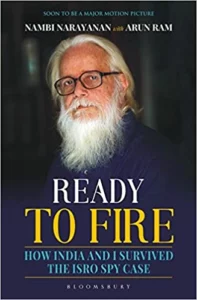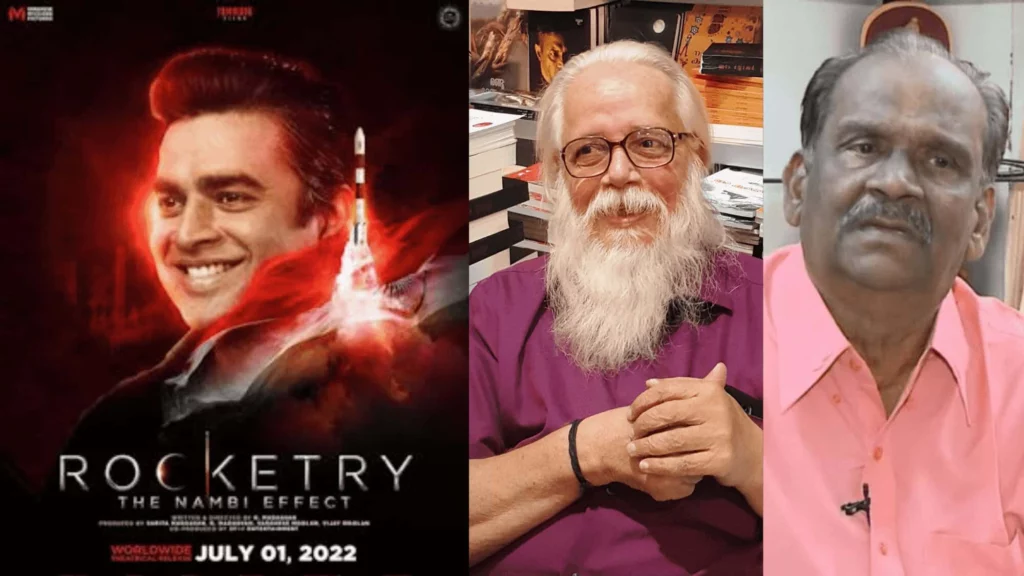Read in : தமிழ்
Recently, a group of ex-colleagues of former space scientist Nambi Narayanan said the movie, Rocketry: The Nambi Effect, either overstated Narayanan’s importance in the Indian Space Research Institute (ISRO) or plainly falsified stuff. D Sasikumaran, a co-accused in the ISRO spy case along with Nambi Narayanan, went so far as to say that the film was 90% lies. He implied Nambi was not tortured.
A E Muthunayagam was critical of the movie, too, as was E V S Namboothiri who was project director of the cryogenic engine. The scientists challenged the contention that Nambi’s arrest led to a serious setback to the cryogenic engine development. In his autobiography as well as the movie, Nambi Narayanan says his arrest had a devastating impact on the cryogenic engine development.
This press meet, coming on the heels of the movie, is only the latest in a series of competing and contradictory narratives of what happened in the ISRO spy scandal. It’s almost like the Japanese movie by Akira Kurosawa, Rashomon. Every person has a different take and is the hero in his personal story in the film. His motives and actions are pure and others are of dubious nature.
This is true in literature as much in everyday reality. In our life story, we are the heroes and others are villains.
Many books have been written about the case including by the stakeholders giving various points of view. Nambi Narayanan’s autobiography, Ready to Fire, co-authored with journalist Arun Ram, is an engineer’s account of a career and life upended by a false case that smacked of big conspiracies and collusion.
M K Dhar and K V Thomas, who were with the Intelligence Bureau and were involved in the investigation, have written about the case. J Rajasekharan Nair, a journalist, recently published an expose that, while recognizing the false case, accused Nambi Narayanan of counter espionage in bringing not just Russian cryogenic engines but also technology from Russia, illegally.
Other ex-ISRO employees who have written about their experiences in the space agency include Muthunayagam in whose account he is the hero or at least the protagonist while others are cohorts, collaborators or adversaries. Ready To Fire is also a similar account.
Muthunayagam was Nambi’s boss for many years and Nambi doesn’t have kind words to say about him. In Ready To Fire, Nambi portrays Muthunayagam as the typical bureaucrat more interested in self-advancement and politicking than the interests of the nation and the organization. Nambi talks about him as someone who sought to upend his ideas and career.
Also Read: Madhavan, really? Rocketry launches aspiring Kamal
Nambi Narayanan portrays Sasikumaran as a betrayer who put Nambi in trouble by falsely confessing to his and Nambi’s spying activities, likely because of torture. Nambi didn’t get along well with Sasikumaran in ISRO although sometimes they worked together well, Ready To Fire says.
Here are a few points that should help us understand the truth.
ISRO is a vast organization and is committed to developing amazing, new technologies that are absolutely at the cutting edge. ISRO, though started as a highly innovative organization by Vikram Sarabhai, has grown into a massive government agency. In India, government structure does not promote innovation and is more about rules, procedures and playing safe. Anyone who tries to innovate, thinks ahead and bends rules is likely to make many enemies. Nambi Narayanan comes across as a loud talking, brash, egotistic and stubborn person who is convinced of his ideas and wants to move ahead and achieve them at all costs, even if it means rubbing others on the wrong side. Top bosses tend to encourage such people since they can achieve things and can keep seniors in check. Nambi has called himself the blue eyed boy of Vikram Sarabhai and Satish Dhawan, who served as ISRO chairman. It often happens that in most organizations people gang up and derail characters like Nambi after their patrons leave. Nambi Narayanan wasn’t quite second rung leadership in the ISRO hierarchy. He had seniors such as Muthunayagam.
Muthunayagam was Nambi’s boss for many years and Nambi doesn’t have kind words to say about him. In Ready To Fire, Nambi portrays Muthunayagam as the typical bureaucrat more interested in self advancement and politicking than the interests of the nation and the organization
Our movies typically revolve around the all conquering, or at least all important hero and his great and foul deeds. Rocketry is a typical Indian movie. Science or technology production, however, happens in teams with the contributions of hundreds and thousands of people. As a movie, Rocketry is full of Eureka moments of Nambi Narayanan that apparently helped him succeed while in reality such flashes of inspiration are not that important. Read To Fire is far more circumspect and Nambi does give due credit to others in the book.
ISRO started out in the 1960s with small solid fuel rockets that they scaled up as Rohini. Abdul Kalam was a champion of solid fuels and made his career out of it, taking it to develop missiles through the DRDO. Nambi wanted to move on from solid fuels. He was an early advocate of an advanced liquid fuels system that makes more powerful rockets and can hence deploy more satellites in space. In cryogenic, fuels such as hydrogen are stored as liquid under sub-zero conditions and carried in the rocket. Cryogenic rockets are even more powerful. In the book, Nambi is generous to Kalam who was a solid fuel man but was a professional and did not block other technologies. Unlike in Rocketry, Ready To Fire doesn’t have a big moment when Nambi corrects Kalam who then meekly accepts Nambi and steps back.
Rocketry talks about Nambi not informing a colleague working with him in France that his baby had died so the colleague would continue working on the rocket development project. This man had a crucial role to play in the engine and Nambi didn’t want the project to be in trouble by having him leave, the movie says. But, in the book, this colleague had only a peripheral role to play.
Also Read: Mars mission: Two facts that disprove R Madhavan
Nambi Narayanan says the US wanted to prevent India from mastering cryogenic technology since it would have been able to launch far bigger satellites cheaply and will take away a share of the emerging satellite market. The US forced Russia, when the USSR was collapsing, to go back on its contract of supplying cryogenic technology to India. Under the cover of bringing only engines, Nambi brought back the elements of the technology as well. Rocketry talks about how not all of the consignments that Russia agreed to send by plane did not arrive because he was put away. He very clearly says his arrest and framing had a chilling effect and delayed the development of the cryogenic engine by some 15 years.
Nambi’s main contribution was the liquid fuel engine, Vikas, which powers the successful PSLV. It does seem that while he orchestrated the bringing of the Russian engines browbeating the US, there were many other leading scientists who played a key role in developing the cryogenic engine. In any case, after the launch of the PSLV, Nambi had decided to retire since he was not going to be made head of the Liquid Propulsion Systems Center within the ISRO.
Sasikumaran says he was not tortured by the IB and Nambi was in IB custody for fewer days, implying Nambi was not tortured. But, Ready To Fire quotes a CBI report to say a doctor found evidence of torture in Nambi’s body. Also, if Sasikumaran was not tortured why would he falsely implicate himself and Nambi in his confession? Why would Maryam Rashida and Fouziya Hasan, the two Malidivian women, implicate everyone?
Nambi, who was on the verge of committing suicide after release, decided to fight back, seek compensation and demand prosecution of officials in police and IB for the false case. His children convinced him to live provoking him by saying they don’t want to be known as the son and daughter of a traitor, as per Ready To Fire. It may well be that Nambi wanted to tell his story forcefully and convincingly to turn public opinion in his favour so justice would be served. In that process, he had to portray himself as the hero and focus on himself. Told in a masala movie format, this story can appear misleading.
Read in : தமிழ்

